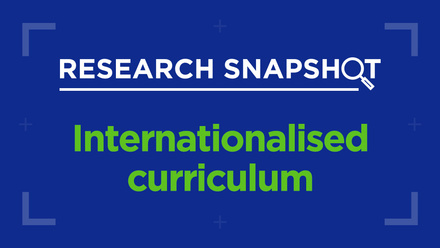Return to in-person learning: 5 strategies for success

The rapid transition to online education due to COVID-19 presented a unique set of challenges and opportunities for higher education institutions worldwide, particularly for international students who were often caught between home and host countries. However, the return to in-person learning appears to be fraught with as much confusion and trepidation. What should higher education institutions be bearing in mind as this second great transition looms large?
Data from a July 2020 survey of international students at the University of Minnesota indicated that, whether international students stayed on or near campus or went home or elsewhere to continue their studies, they experienced challenges including: (1) a lack of connection, especially with peers; (2) struggles with time management and working across time zones; and (3) a lack of motivation and ability to focus outside the campus or classroom environment. These challenges were not unique to international students studying in the US; a study examining the transition to online learning among Erasmus students in Europe following the initial transition online noted similar findings.
A complex picture
Despite the challenges, students seem hesitant to just ‘go back to normal’ too quickly. Follow-up focus group interviews conducted in February and March 2021 at the University of Minnesota asked international undergraduate students about the upcoming, likely in-person, academic year. While there was a collective sense of excitement among students living both locally and abroad, there were also a lot of questions and concerns. After so much time feeling isolated and disconnected from campus and peers, students in the focus groups wondered what it would be like to be back on campus. Students who had been on campus prior to COVID-19 wondered if their friends would come back too or whether they would have to build new social networks and relationships. Others wondered if the online connections and friendships they have made would continue upon return to campus and in real life. For students who began their studies or transferred to an institution during the pandemic, they wondered what the campus climate and culture is actually like. However, while students struggled with time management and ability to focus, they also very much appreciated the flexibility that online classes offered.
So as we can see, students are thinking about how they will fit everything, including more social activities and commutes, back into their schedules and lives. They are also hoping faculty and instructors will continue to be flexible and understanding and provide varying modes of access and participation to classes. Perhaps what is weighing the most on students’ minds is more logistical: they are concerned about ongoing COVID-19 safety precautions or contingency plans. They wonder if they will get information about visas, course offerings, housing, vaccines, and more in time to make workable plans.
While these concerns about a return to campus were expressed by international students at the University of Minnesota, they are relatable and likely top of mind for international students around the world trying to get (back) to host institutions and countries this year. As higher education institutions and their faculty worldwide prepare to welcome students back to campus, we are recommending the following strategies to help both international students and the universities to achieve a smoother transition.
1) Provide clear and timely communications
One of the concerns students voiced in focus groups was about the challenges of making plans related to moving across the world for their studies. This included decisions about housing, visas, course registration, travel information and more. So, providing up-to-date information and any reassurance related to immigration regulations, admissions (and deferral) options, housing policies, course modalities, and universities’ COVID-19 precautions or contingency plans would offer some reassurance. This is especially important for students from marginalised backgrounds who may not have all the same access to sources of information, financial support, or other social and cultural capital.
2) Retain some (asynchronous) online or flexible offerings
International students overwhelmingly emphasised the benefits of recorded lectures and class sessions. Therefore, encourage more faculty to record their lectures using captioning, and editing captioning whenever possible. Alternative ways for students to participate and engage with course materials and peers can also benefit students with varied barriers for in-person learning and contribute to a more inclusive campus.
3) Engage in intentional international and domestic student integration efforts
International students in our survey voiced feeling isolated and having difficulty interacting with peers in the online space, and the Zoom breakout rooms were often awkward. Intentional support to bring students together and focus on intercultural communication and global learning could be helpful for all students, especially in light of many institutions’ internationalisation goals and increased interest in virtual and The future of student mobility is hybrid and exchange programmes.
4) Further support and recognise faculty and staff
It’s not just students who struggle. Many faculty and staff put in extra hours and efforts to learn new ways of teaching and assessing students. Many have offered their students extra support, sometimes at unconventional days or times, to accommodate different time zones. This dedication to students and institutions deserves professional recognition and validation.
5) Promote the physical, mental, and emotional well-being of the university community
Mental and physical health was something that nearly every student in our focus groups brought up. Institutions need to foster a sense of caring for oneself and each other. This includes raising awareness and providing ample and easy access to wellness resources and activities such as vaccination clinics, testing facilities, mental health providers, listening circles, safe processing spaces and more.
Most of us are ready and anxious to move into a post-pandemic world – but most are not ready to go back to exactly how things were. This transition presents an opportunity for higher education institutions worldwide to create a new normal, one that is more humanistic and equitable.






